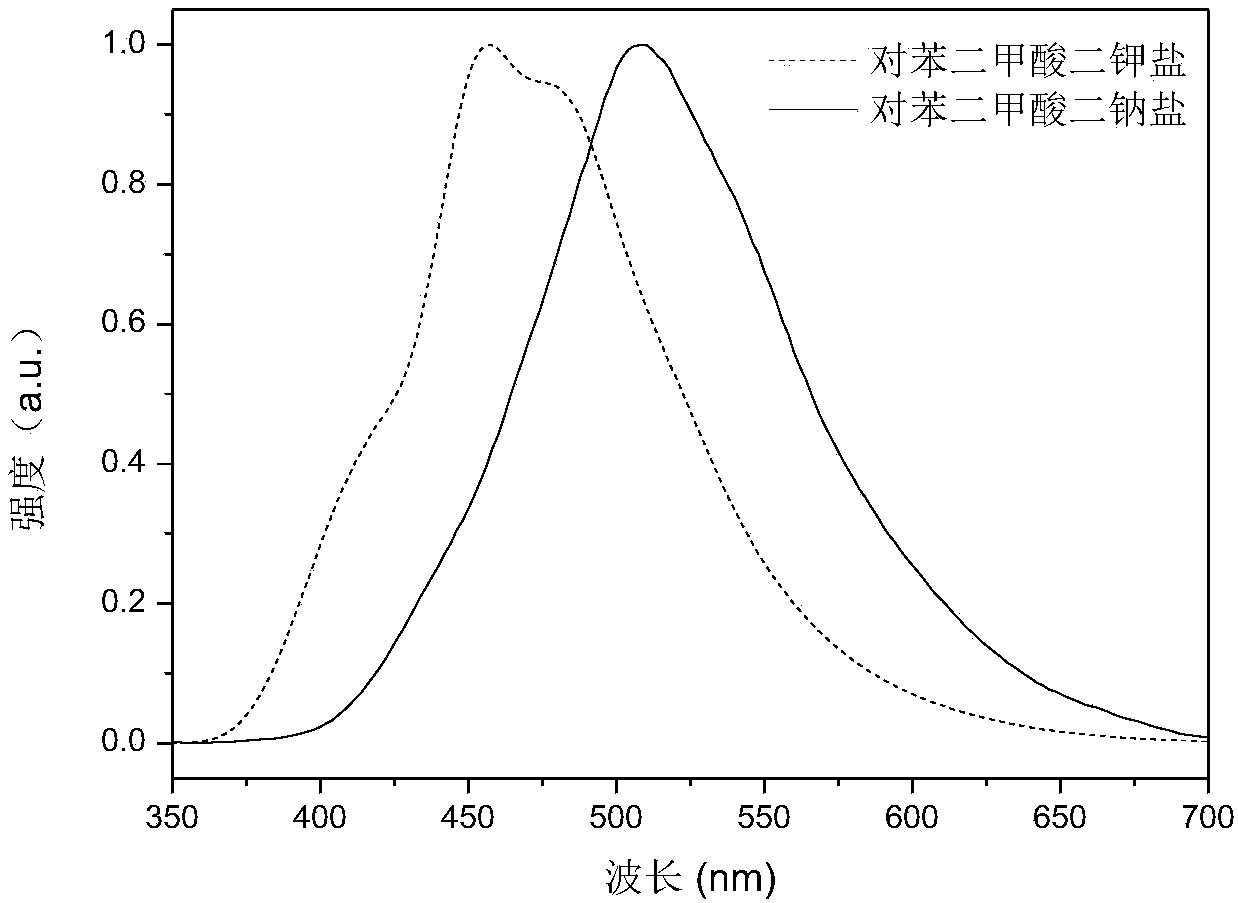Preparation and application method of luminescent color adjustable long afterglow material based on organic salt ionic crystals
An organic salt, long afterglow technology, applied in luminescent materials, organic chemistry methods, organic chemistry and other directions, can solve the problems such as the inability to meet the application requirements of long afterglow materials, and achieve the effects of low raw material prices, huge application potential, and simple preparation methods.
- Summary
- Abstract
- Description
- Claims
- Application Information
AI Technical Summary
Problems solved by technology
Method used
Image
Examples
Embodiment 1
[0033] Synthesis process of organic long afterglow material: Weigh 0.2g of terephthalic acid, measure 0.45mL of ammonia water into a 10mL centrifuge tube, add 8mL of deionized water, and sonicate until the terephthalic acid is completely dissolved. Then the centrifuge tube is put into 50 DEG C of oil baths, water is volatilized, and the crystal of transparent monohydrogen ammonium terephthalate will be separated out at the bottom of the centrifuge tube after a few days (synthetic process is shown in figure 1 ). Ammonium monohydrogen terephthalate crystals belong to the monoclinic crystal system, C2 / c space group (see the attached figure 2 ). The unit cell size is: α=90.00°, β=97.96(3)°, γ=90.00°, The long afterglow lifetime of this material is 0.59s.
Embodiment 2
[0035] Use the same chromophore anion to change the type of cation in the organic salt, thereby changing the crystal packing mode, and then affecting the long-lasting luminous color: using the same method to synthesize dipotassium terephthalate and disodium terephthalate, All are transparent massive crystals. Dipotassium terephthalate crystals belong to the monoclinic system, P2 1 / c space group. The unit cell size is: α=90.00°, β=113.08(3)°, γ=90.00°, The long afterglow luminescence spectrum peak of the material is at 546nm, and the lifetime is 0.50s. Disodium terephthalate crystals belong to the orthorhombic crystal system, Pbc2 1 space group, the unit cell size is: α=90°, β=90°, γ=90°, The long afterglow luminescence spectrum peak of the material is at 508nm, and the lifetime is 0.42s. Phosphorescence spectra of dipotassium terephthalate and disodium terephthalate see attached image 3 .
Embodiment 3
[0037] Visual detection of ammonia and hydrogen chloride gas: according to the attached Figure 4 Put the ground TPA powder in a 5mL small beaker, then pour 20mL of ammonia water on a petri dish with a diameter of 10cm and put the small beaker into it, and finally pour the petri dish into a 1L large beaker buckle up. Take it out after standing for different time (10min, 30min, 1h). It can be found from the XRD spectrum that the phase gradually changes from terephthalic acid to diamine terephthalic acid. The afterglow color also gradually changes from yellow-green to blue-green (520-506nm). The same method is used to recover the afterglow color. After grinding the sample that has been smoked with ammonia gas, it is back fumigated with hydrogen chloride. After 7 hours, the afterglow color returns to the original yellow-green color. Figure 5 .
PUM
 Login to View More
Login to View More Abstract
Description
Claims
Application Information
 Login to View More
Login to View More - R&D
- Intellectual Property
- Life Sciences
- Materials
- Tech Scout
- Unparalleled Data Quality
- Higher Quality Content
- 60% Fewer Hallucinations
Browse by: Latest US Patents, China's latest patents, Technical Efficacy Thesaurus, Application Domain, Technology Topic, Popular Technical Reports.
© 2025 PatSnap. All rights reserved.Legal|Privacy policy|Modern Slavery Act Transparency Statement|Sitemap|About US| Contact US: help@patsnap.com



